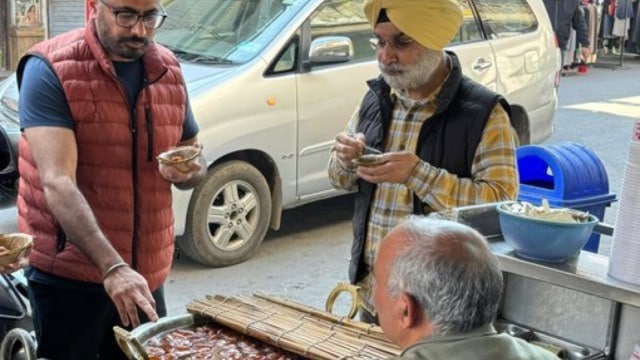100 years after his grandfather shared stage with Nehru, India’s ex-US envoy stirs political buzz in Amritsar
Taranjit Singh Sandhu, whose grandfather was also among the founders of Shiromani Gurdwara Parbandhak Committee, has been on a meeting spree in his own city.
 Taranjit Singh Sandhu (right) savours jalebis and gulab jamuns at Sharma Sweet Shop in Amritsar. Express photo
Taranjit Singh Sandhu (right) savours jalebis and gulab jamuns at Sharma Sweet Shop in Amritsar. Express photoJust three weeks after bidding adieu to Washington DC as Indian ambassador to the US, Taranjit Singh Sandhu has hit the streets of Amritsar. But hardly anyone noticed him as he savoured mouthwatering jalebis and gulab jamuns standing outside Sharma Sweet Shop in the city.
Taranjit Singh Sandhu may be a big name in the world of diplomacy, but he has begun reintroducing himself to his own city. He started his interaction on February 23, the birth anniversary of his grandfather Sardar Teja Singh Samundri, paid obeisance at the Harmandir Sahib and returned to the X platform, where he had been silent since he left the US.
Samundri was among the founders of the Shiromani Gurdwara Parbandhak Committee. A hall in his name is designated at the SGPC for the body’s elected house to hold meetings.
Exactly 100 years ago, Samundri was not only active in the SGPC and Sikh League but he was also a national leader of the Congress. As a Congress Working Committee member, he used to share stages with Jawaharlal Nehru, Madan Mohan Malaviya, Maulana Abdul Kalam Azad and others.
Samundri had collected huge funds for the civil disobedience movement. His statement that all Hindus, Muslims and Sikhs will come together under one flag for the civil disobedience movement was cited by the British to invoke sedition charges against him.
Samundri also found a place in a famous painting on the civil disobedience movement which featured only Mahatma Gandhi, Nehru, Subhas Chandra Bose and six other national leaders.
Taranjit Singh Sandhu’s father Bishan Singh Samundri was an educationist and the founder vice-chancellor of Guru Nanak Dev University. The family’s ancestral village is Rai Burj Ka in Tarn Taran district, which the former ambassador visited recently.
Sandhu, who went to Sacred Heart and St Francis School in Amritsar, is now on a meeting spree with locals, mostly from the city’s elite class. He was seen with senior doctors at Green Avenue — a meeting that he said involved “enlightening discussions on healthcare, including the challenges faced by the medical colleges in Amritsar”. He sat with young entrepreneurs and had “exciting conversations on the challenges and opportunities within various economic sectors”.
Sandhu also interacted with a group of entrepreneurs and professionals at the Punjab Lawn Tennis Association’s complex in Company Bagh “regarding the state of Amritsar’s economy, infrastructure, education, sports and skilling opportunities”.
He also met women professionals of the city and representatives of industries, textiles, skill development and the hospitality sector. Apart from these closed-door meetings, Sandhu also met farmers in border areas.
Such activities of the diplomat just before the parliamentary elections have triggered speculation that he may join politics. His grandfather had multiple layers as a politician. However, Sandhu has so far kept his cards close to his chest about his political ambitions, if any.
As Sandhu is exploring the city, people who know him still look at him as a diplomat.
“It is good that such a fine diplomat has come back to his city after experiencing all the world. He may have great ideas for the city. But I am not sure if he would be able to become a politician. He has such a grace that it is impossible to imagine him seeking votes. I hope some political party would respect his capabilities and send him to the Rajya Sabha,” said a businesswoman who interacted with Sandhu.
Union minister Hardeep Puri, another diplomat, had unsuccessfully contested Lok Sabha polls from Amritsar twice. Before Puri, Arun Jaitley had also failed to win the seat for the BJP.
Though Sandhu has, so far, not expressed any intention to join politics, Amritsar may pose a different kind of challenge for him.







